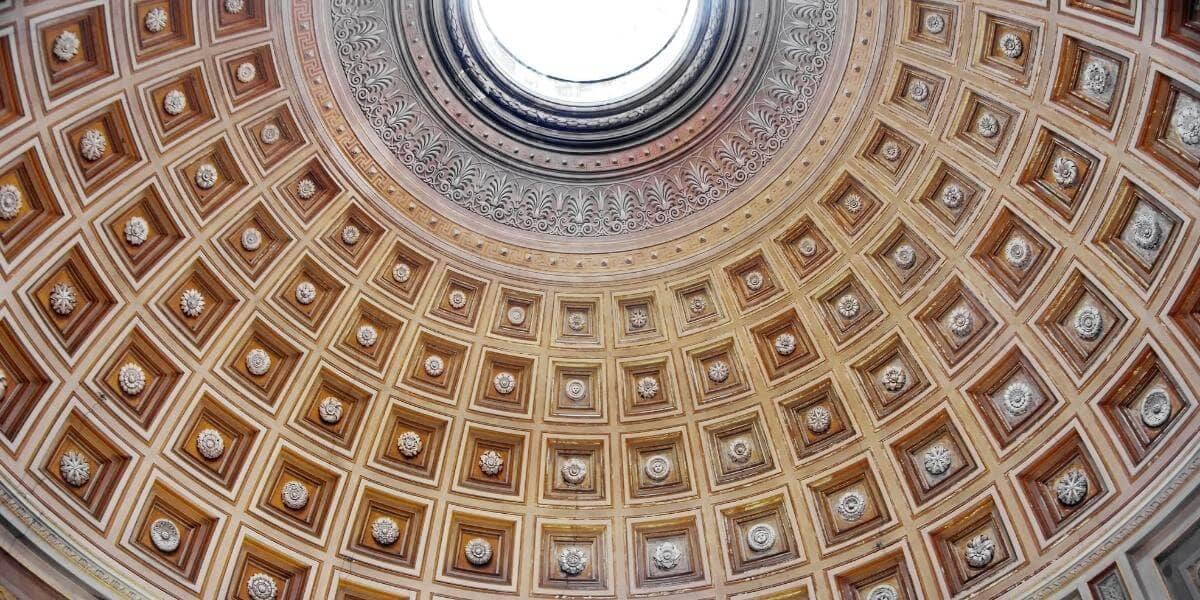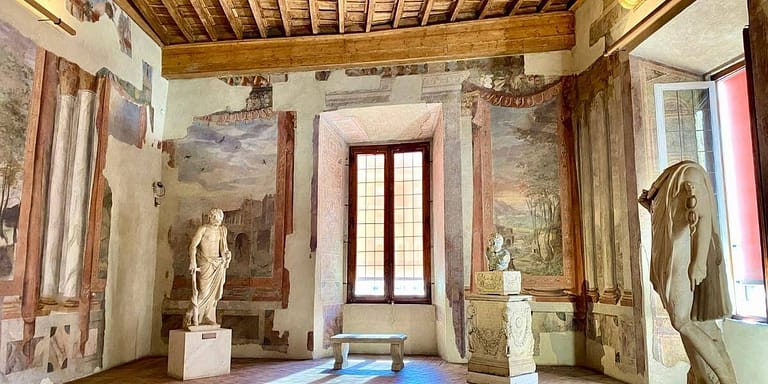Roman architecture: why it still matters 2000 years later
Roman architecture changed the world in ways that even the Romans couldn’t predict. While other civilizations constructed grand monuments, Roman construction revolutionized building techniques and left a lasting legacy. Roman builders didn’t invent construction, but they improved existing methods and styles by leaps and bounds.
The glory that was once the Roman Empire might be gone, but its legacy lingers. You can find its influence all over the world. Monuments, buildings and extensive ruins we see today are all testaments to the innovation and durability of Roman construction that changed the way we build. Not only did the Romans revolutionize architecture, they continuously influenced other styles long after their empire fell from power.
Affiliate Disclosure – This post contains affiliate links. If you make a purchase through these links, I may earn a commission. This doesn’t affect your purchases or any fees you may pay for the product or service. Read more in my DISCLAIMER.
Why is Roman architecture important?
As they say, Rome wasn’t built in a day. The Greeks, Etruscans and Egyptians erected temples, theatres and villas in the Mediterranean long before the Romans. There is a reason why today we still talk so much about Roman construction and its influence.
Romans were very good at taking existing things – culture, art, politics, etc. – from other civilizations and improving them. However, it was the architecture where the Romans outshone all others. Roman architecture is vital because its innovation and functionality paved the way for future generations of builders. We wouldn’t have modern construction without the knowledge and invention of Roman architects.

The architecture of Ancient Rome
The Romans erected massive public buildings and were responsible for significant infrastructure projects that improved the lives of their people. From housing projects to sewers and sanitation, Romans built with purpose and function in mind. Architecture and engineering helped Rome grow in power and influence. Some of the Empire’s most outstanding construction achievements came between 40 BC to about 230 AD.
Concrete was a critical component of the architecture of Ancient Rome. By introducing their brand of concrete, Roman architects were able to erect structures never seen before or since. Ancients mixed limestone and water with an aggregate like rocks, stones and sand. The Romans revolutionized the practice by adding volcanic ash (called pozzolana). This game-changer allowed Roman architects to create durable structures that were previously inconceivable. They also stood the test of time.

Architecture as a statement of power
Romans used architecture to demonstrate their power. Roman emperors and generals erected triumphal arches, columns and obelisks to commemorate victories, celebrate acquisitions of new colonies, significant public events, construction achievements and deaths of imperial families or accessions of new emperors.
They built massive amphitheaters for the entertainment of the masses and to stay in favour of the public. Grand infrastructure projects like baths, sewers, roads and temples not only improved the lives of residents, they were a testament to the influence and power of the Empire.
Investing in large projects also demonstrated the wealth of the Roman Empire not only to its people but to those that might want to challenge that power.
Innovation in Roman construction
Innovation in building materials allowed Romans to experiment with architectural styles. This allowed Romans to build bigger, better and faster. By incorporating arches, vaults and domes, Roman architects created some of the most spectacular buildings that were revolutionary at the time and still inspire awe today.
Romans took elements of Greek architecture and adapted them to their own needs. While the Greeks relied on simplicity of structure, using columns to hold up pediments and favouring geometric designs, the Romans took it further. Romans added more depth to their buildings by mastering arches and vaults. They created magnificent vaulted roofs, higher spans, and larger spaces with fewer columns.

Architecture as a catalyst for the growth of cities
Romans were masters at building roads, which was a crucial element of Rome’s success. They constructed over 400,000 km of paved roads across Roman territories, allowing for a quicker and safer movement of people and goods. Soldiers, messengers and traders could move across the Empire faster while the roads connected settlements with Rome.
Aqueducts were also a significant development that was instrumental to growth. A constant freshwater supply allowed for a separation of drinking water from sewage, somewhat improving public health by Roman standards. Bringing water from a distant source also allowed new development that wouldn’t have been possible in places without a water source.
Inventions of Roman construction
Many of the things we take for granted today were invented or perfected by the Romans. Roman construction didn’t rely on the if-it’s-not-broken-don’t-fix-it adage and instead focused on how to improve it. Many of the inventions in Roman architecture existed before the Romans took matters into their own hands, and they ran with them.
Roman Arches and vaults
Other civilizations used arches and vaults, but Romans mastered their use. They figured out that arches could withstand more weight than columns, which enabled them to build on a larger scale without relying on columns. Arches didn’t have to be semi-circular to work either, and Romans used them for practicality and aesthetic effects. Arches also allowed them to create bridges that spanned great distances and over rivers and valleys.

Roman Domes
Domes are designed to cover large spaces with no internal supports. The Romans incorporated this feature into their design, creating spectacular large, open spaces. They included that design in bathhouses, temples, basilicas and other structures. One of the best-preserved Roman buildings and an outstanding example of Roman construction is the Pantheon in Rome.

Roman Roads
Roads weren’t a Roman invention, but the Romans took the concept and perfected it. They were the first to construct paved roads that connected all parts of the Empire. Roman road construction was superb, so much so that Roman roads are still in use today. The road infrastructure was so extensive that it created the saying, “all roads lead to Rome.”
Many became national highways, while others were expanded and built over. Despite that, you can still find Roman roads with original cobbles intact. The Roman road network helped build transportation networks across Europe. We have also inherited many Roman features found along the ancient roads, including hotels, restaurants and rest stops.

Roman Aqueducts
Aqueducts are another remarkable feat of Roman engineering. While other civilizations built and used aqueducts, the Romans just had to do it better. The extensive network of pipes, tunnels, bridges and canals were part of the Roman aqueduct systems that brought fresh water to highly populated areas. The construction of aqueducts required a lot of planning and mapping, and Roman engineers incorporated gravity and natural slopes to channel the water from the source to the destination.
Romans didn’t just use the water for drinking and irrigation. Aqueducts supplied water for extensive use in bathhouses, sewers, fountains and private baths. We can still see many of the structures today across valleys and rivers.

Roman Sewers
Roman ingenuity also extended to mundane things like sewage and personal hygiene. It was more advanced than anything else that came before. The Roman engineers created a complex sewage system modelled on a simpler Etruscan version that was mainly used to drain marshes and storm runoff.
Romans had a sophisticated plumbing infrastructure that supplied water to baths, latrines and sewers. The water from bathhouses was also reused to flush drains and remove waste. Those that couldn’t afford their own were encouraged to use public toilets and baths. It’s important to note that while Roman sewage was sophisticated for its time, it was far from what we consider hygienic by modern standards.

Roman Baths
Bathhouses were a massive part of Roman culture. While the baths were more of a luxury during the early days of Rome, they eventually became the norm. Public bathhouses served as health clubs and communal gathering places where you went to bathe and socialize.
The bath complexes offered several chambers with different temperatures, swimming pools, exercise rooms and places to read and relax. The Romans incorporated under-floor heating, which provided hot and cold water to the baths, which was handy during colder days.

Roman Amphitheatres
Another hallmark of Roman construction is the amphitheatre. Like modern sports arenas and concert halls, the amphitheatres were designed to entertain the masses. They were used for mass entertainment, mainly for gladiatorial games, animal slayings and executions. Death and gore were all the rage.
About 230 Roman theatres have been found across the territory of the Roman Empire. The best-preserved example we know today is the Flavian Amphitheater, better known as the Colosseum, in Rome. It was the grandest and most spectacular of them all, and all others were modelled after it.

Roman influences on other architectural styles
After the fall of the Roman Empire, many of the Roman structures were stripped of their marble and left to the elements. Others were destroyed or repurposed. Many Roman innovations, like sewers and plumbing, were forgotten. But that wasn’t the end of them.
Interest in Roman architecture didn’t completely go away. However, it was the Renaissance that ushered in a renewed interest in the classics. Classical architecture covered Greek, Etruscan and Roman designs from which new styles evolved.
Romanesque
Romanesque architecture was all the rage sometime between the 6th and 11th centuries across medieval Europe. Inspired by Roman, Byzantine and Germanic styles, Romanesque style gave us monasteries, churches and castles with thick walls, large towers and sturdy pillars. Arches and vaulted ceilings were still used here.
Examples of Romanesque architecture include the Tower of London (London, UK), Maria Laach Abbey (Andernach, Germany), Cerisy Abbey (Normandy, France), the Leaning Tower of Pisa (Pisa, Italy) and Tum Collegiate Church (??czyca, Poland).

Neoclassical
The revival of Classical architecture came around the mid-18th century. During the 18th and 19th centuries, the Neoclassical style was widespread across Europe and thrived in the United States. Following the excess of the Rococo style, Neoclassicism was all about simplicity, geometric design and grandeur inspired by classical architecture. Many buildings of this time featured columns, domes and spare use of ornamentation.
Examples of Neoclassical architecture include the Pantheon (Paris, France), Brandenburg Gate (Berlin, Germany), the British Museum (London, UK), Lutheran Cathedral (Helsinki, Finland) and the University of Virginia Rotunda (Charlottesville, US).

Romanesque revival
Romanesque Revival became popular mid-19th century. It drew on medieval Romanesque architecture for inspiration and featured smaller and simpler arches and windows. Many churches, university buildings, prisons and public buildings of the time were done in this style.
Examples of Romanesque Revival architecture include University College (Toronto, Canada), The Smithsonian Institution Building (Washington, US), Fisherman’s Bastion (Budapest, Hungary), Sts. Peter and Paul Cathedral (Lubumbashi, Democratic Republic of the Congo) and the Natural History Museum (London, UK).

Palladian
Palladianism was influenced by the 16th-century Venetian architect Andrea Palladio. It gained popularity in Britain mid-17th century and returned to fashion in northern Europe and North America in the early 18th century. Palladian architecture became an evolution of Palladio’s original concepts and relied on Classical design principles with lots of symmetry, strict proportions and unadorned exteriors.
Examples of Palladian architecture include Queen’s House (Greenwich, UK), the Hammond–Harwood House (Annapolis, US), Government House (St. John’s, Canada), Basildon Park (Berkshire, UK) and the Rotunda at the University of Virginia (Charlottesville, US).

The legacy of Roman architecture
The Romans took the Greek post-and-lintel construction style and revolutionized architecture by creating the Concrete Revolution. Thanks to their ingenuity, we can admire many outstanding Roman construction projects existing today.
Even after the fall of the Roman Empire, the interest in Roman architecture never went away. Their construction prowess, style and innovation, combined with the longevity of Roman construction, have inspired builders for centuries, showing them that anything was possible.
I think the Romans would enjoy knowing that we still talk about their spectacular legacy today and how much the world has benefitted from their innovation. Would they be pleased that so many buildings and temples are still standing today, or would they be horrified at what’s left of them? We can only speculate.







